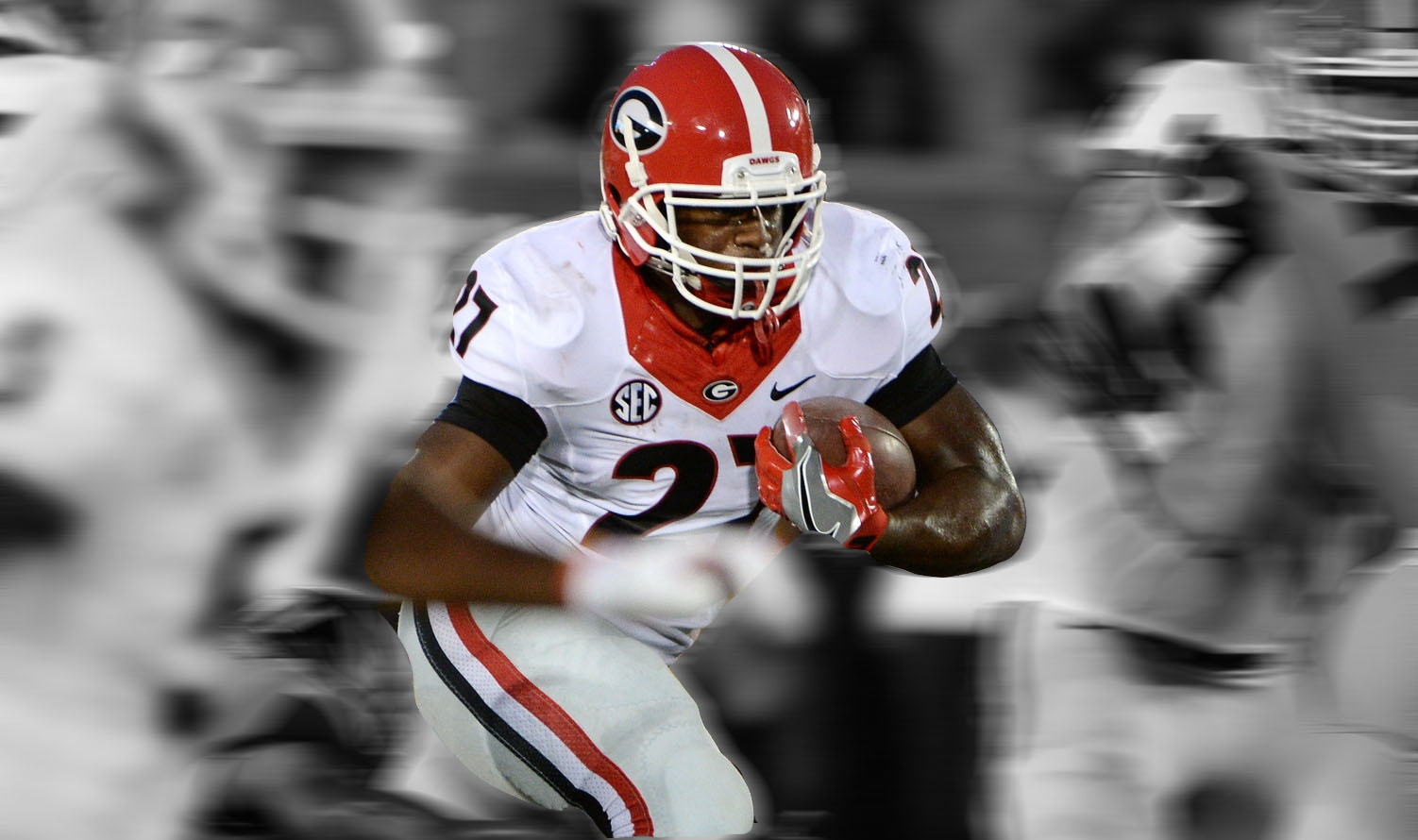
A weekly look inside an SEC playbook.
If there’s anything Georgia should be able to rely on in 2016, it’s the running game: On paper, the Bulldogs boast arguably the deepest, most diverse backfield in the nation. The headliners, juniors Nick Chubb and Sony Michel, are a thunder-and-lightning duo that have easily lived up to their advanced billing as recruits by piling up more career rushing yards (4,368) and touchdowns (37) than any other active FBS teammates.
There’s quality depth behind them, courtesy of true freshman Brian Herrien, and a wildcard, diminutive slot back Isaiah McKenzie, who poses a unique threat on speed sweeps and reverses. For an offense adjusting to a new coordinator, an unproven set of receivers, and (as it turns out) a true freshman quarterback, the ground game was the one aspect that offered some semblance of stability.
And initially, at least, it got off to a reassuring start. In Chubb’s first game back from the grisly knee injury that ended his sophomore campaign, he logged 32 carries for 222 yards and two TDs against North Carolina, erasing any doubts about his capacity to resume carrying a full workload or the new coaching staff’s willingness to let him do it. Excluding the 2015 game in which he was injured, his triumphant return in the Georgia Dome extended Chubb’s streak of 100-yard outings to 13 in a row.
It’s been downhill from there. The following week, Georgia was largely outplayed at the line of scrimmage by an FCS patsy, Nicholls State, that arrived in Athens as a 55-point underdog; in the end, UGA was forced to rely on a defensive touchdown for the winning margin in a 26-24 nail-biter. Chubb managed just 80 yards against the ostensibly outmanned Colonels, bringing his streak to an abrupt end. At Missouri, the Bulldogs barely cracked 100 rushing yards as a team on a paltry 2.7 per carry. At Ole Miss, they started slowly and fell into such a massive hole in the first half that the final numbers on the ground (230 yards on 5.2 per carry) bore no resemblance to the reality of a 45-14 debacle — the vast majority of that output came in garbage time, after it became obvious a comeback was out of the question.
Even buoyed by the successful opener against UNC and the misleading totals against Ole Miss, the conventional rushing statistics through four games are blah (Georgia ranks 47th nationally in yards per game and 61st in yards per carry) and the advanced stats are downright depressing: According to Bill Connelly’s S&P+ ratings, the Bulldogs are 76th in rushing success rate and 97th on standard downs, when they keep the ball on the ground nearly two-thirds of the time.
With numbers like that, the learning curve for 18-year-old quarterback Jacob Eason has already been steeper than expected, and the results have been mixed. Against Missouri, he held up fine, attempting an astounding 55 passes with three touchdowns, including the fourth-down game-winner to McKenzie with less than two minutes to play.
Against Ole Miss, not so much: Eason served up a pick-six on UGA’s second series of the game and never seemed to recover, finishing 8-of-19 passing in the first half with a long completion of only 16 yards. (To be fair, his receivers weren’t much help.) For the game, the Bulldogs’ longest gain by ground or air was a 29-yard completion by its punter on a fake punt.
But inconsistency in Eason’s situation shouldn’t come as a surprise. Ninety-one attempts in his first two conference games — both on the road — is a lot to put on a true freshman, even one with Eason’s obvious talent. Eventually it will be his offense. If Georgia has any hope of salvaging a serious run in the SEC East this year, though, it will have to regain in its footing in the running game, and it will have to do it ASAP: A second conference loss this weekend against the de facto East frontrunner, Tennessee, could effectively put the division out of reach.
BREAKING AWAY
The most glaring issue with the running game so far isn’t really its consistency, or lack thereof: It’s the near-total absence of big plays. Through four games Georgia is tied for dead last in the SEC with three runs of 20 yards or longer, and has only broken one run for more than 30 yards. For a unit that led the conference in 20-yard runs in 2014 (with 34) and ranked second in 2015 (29), that’s a significant drought.
And for one that often struggles to finish off sustained drives in the end zone, as Georgia has, the shortage of quick-strike options can also mean a lot of potential points left on the field.
The lone exception to that trend came late in the fourth quarter against North Carolina, on the play that sealed the victory against the Tar Heels and seemed confirm that Chubb was back to his old, highlight-hogging self. On paper, the design could have been lifted directly from the days of Student Body Right or a Vince Lombardi news reel, or from many years’ worth of Georgia game film under Mark Richt: A simple downhill toss to Chubb, running out of the I-formation behind a fullback (Christian Payne), a pulling tackle (Greg Pyke), and a pair of offset tight ends (Jeb Blazevich and Jackson Harris) cracking back.
Adding to the old-school look on this play, UNC — fully expecting run in a clock-killing situation for Georgia — has walked up all 11 defenders within 5 yards of the line of scrimmage.

Although Pyke (No. 73 below) and Payne (No. 47) are leading the way into the flat, the most critical block at the outset is the crack by Blazevich (No. 83), who motioned inside of Harris just before the snap to put himself in position to seal the play-side defensive end. Initial penetration from that end could blow up the play in two ways, by a) Cutting off Payne’s path to the outside, preventing him from clearing a path downfield; and b) Forcing Chubb to change direction in the backfield before he’s able to build up steam. Neither happen because Blazevich connects on his block, as does Harris on one of the Heels’ aggressive, run-oriented safeties.

Carolina has one player outside the hash marks, 185-pound cornerback Des Lawrence, to take on the lead block from Pyke, who goes about 315; for Lawrence that encounter is less about containing Chubb or cutting off his running lane than surviving. Meanwhile, Harris has flattened his man to the ground, altering the pursuit angle of linebacker Andre Smith (No. 10) just enough for Payne to square up for a block that will clear an alley to daylight.

Even with more or less ideal blocking, Chubb doesn’t have an unfettered path — a couple of UNC defenders pursue well enough to have a plausible shot at bringing him down between 5 and 10 yards downfield, and Lawrence is able to make a diving effort in the process of eluding the block from Pyke. Due to the lack of penetration, though, what Chubb have is the space to hit the crease at full speed, after which point plausible shot becomes no hope whatsoever.
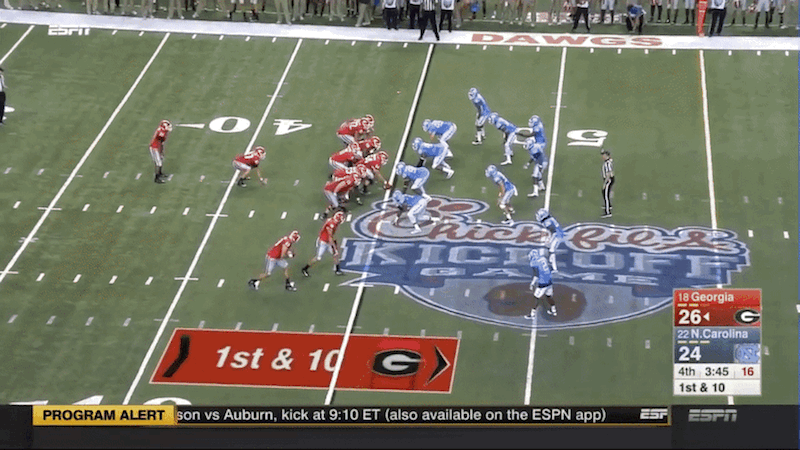
Although Chubb’s scoring run is the only really big run Georgia has broken, covering 55 yards, the Bulldogs also scored on essentially the exact same play earlier in the game, with Brian Herrien doing the honors from 19 yards out in the second quarter. Again, the key blocks at the snap are the crack backs by Blazevich and wide receiver Jayson Stanley (No. 2) on the play-side defensive end and outside linebacker, respectively, again freeing up Pyke to kick out the cornerback and Payne to clean up downfield.
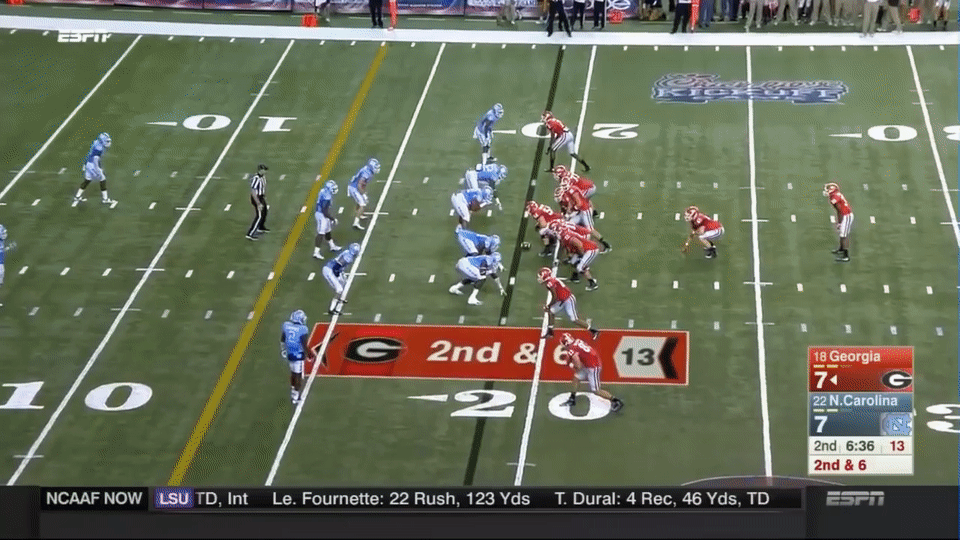
Unlike Chubb a couple quarters later, Herrien did have an unfettered path to the pylon and got there untouched. But the key to springing him was the same: Cutting off penetration, allowing the back to hit the hole on time, at full speed, and accelerate through it without having to dodge traffic. When it works, it’s a thing of beauty.
SPACE INVADERS
When it doesn’t work, well, you have the past three weeks. The Bulldogs haven’t been hapless on the ground, by any means. But they haven’t blocked anything as well as they did that pair of touchdown runs in the opener, and they’ve often looked out of sync. Between the tackles, especially, they’ve come up mostly empty.
Formation-wise, first-year coordinator Jim Chaney has added a healthy dollop of spread sets on top of a traditional, two-back foundation, and attempting to run out of the former has been an exercise in frustration. Part of that has to do with Eason’s statuesque presence, which automatically rules out large swathes of any spread-to-run playbook — kid’s got an arm, but at 6-foot-5, 230 pounds, he’s hardly a threat to keep the ball on a zone read (or any other designed run) and defenses don’t treat him like one.
More to the point, though, the front five has simply struggled to open lanes and allowed far too much traffic behind the line of scrimmage before the backs even have a chance to react.
Sometimes the problem is as basic as a busted assignment — that’s what happened here, for example, when Georgia faced seven Missouri defenders in the box with only six blockers and simply neglected to block the Tigers’ best player, Charles Harris (No. 91 below, at right defensive end) on a straightforward off-tackle run by Chubb.
A more seasoned quarterback might have checked out of the play; a more mobile one might have slowed down an unblocked player with the prospect of his taking off. Not here. Instead, UGA left tackle Tyler Catalina (No. 72) peeled off to catch a blitzing linebacker who had much less of a chance of chasing the play down from behind, leaving Harris free to knife in untouched and bring down Chubb for no gain.
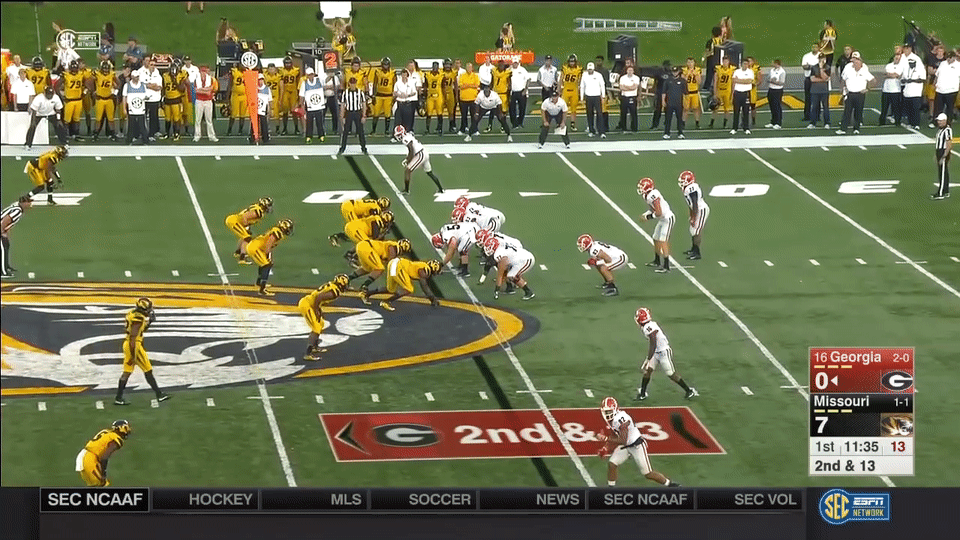
Or take this run against Ole Miss, in which Catalina and left guard Isaiah Wynn (No. 77) part like the Red Sea for Rebels’ defensive tackle Breeland Speaks (No. 9); Wynn blocks down, assisting a double-team on the nose tackle, Catalina looks confused while blocking no one, and Speaks fires straight into Chubb’s face as he takes the handoff. Somehow Chubb manages to elude the tackle for loss, because he’s good, but not good enough to make any hay out of it once he’s been redirected in the backfield:
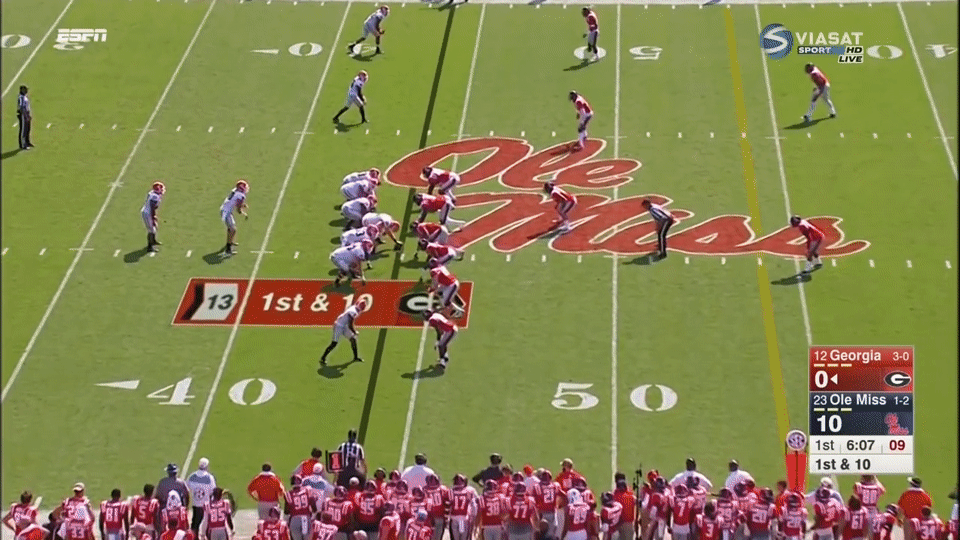
But mental busts can be corrected. More often, and more concerning, is the frequency of blockers simply getting beaten at the point of attack. On this play, UGA wants to pull Wynn from his left guard spot to lead Sony Michel around the right side on a counter. The problem is that Missouri’s defensive end on the right side, Marcell Frazier (No. 55) beats tight end Jeb Blazevich off the snap and successfully caves him into the backfield, cutting off Wynn and clogging the intended running lane; Michel, one of the shiftiest open-field runners in the country, is forced to dodge his own linemen 2 yards behind the line of scrimmage before being swarmed over for no gain.
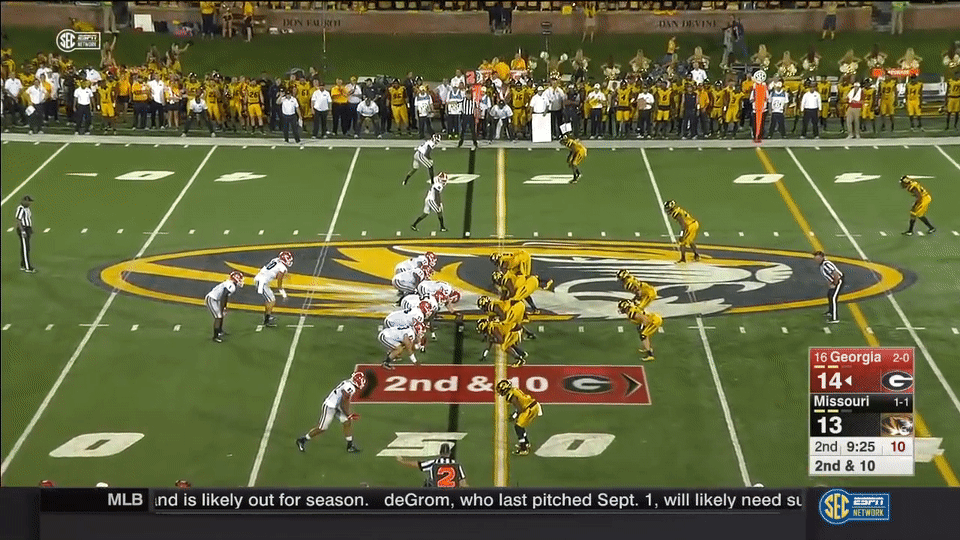
Later on, Georgia attempted to cross up the Tigers by using Isaiah McKenzie (No. 16 below) as a pre-snap decoy to disguise an off-tackle counter to Chubb; this time, he’s running behind center Brandon Kublanow (No. 54) and right guard Lamont Gaillard (53), who are both pulling to the right.
Immediately Chubb has two problems: One, Mizzou DT Terry Beckner Jr. (No. 79) has blown past the flailing down block of the right tackle, Pyke, forcing Chubb to bounce wide; and two, outside linebacker Donovin Newsom (25) has successfully cut off the outside, occupying both Kublanow and Gaillard in the process. With nowhere else to go, Chubb is forced to cut upfield into the pursuing flotsam, again merely escaping a TFL after being redirected by penetration.
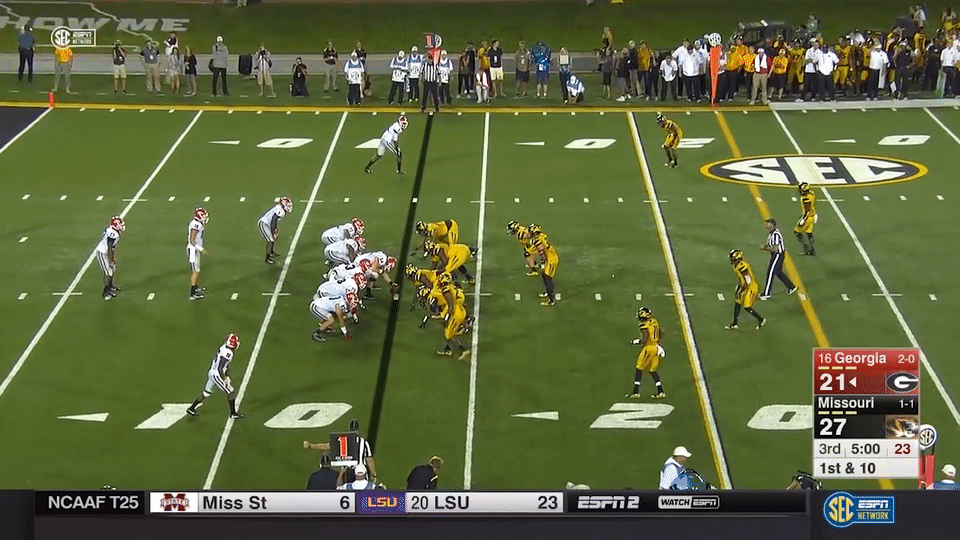
Uglier still, on the first play from scrimmage against Ole Miss the entire line of scrimmage was effectively redrawn 3 yards in the backfield, where both Catalina and Wynn wound up after being beaten by defensive end Marquis Haynes (No. 10) and defensive tackle D.J. Jones (93), respectively. Here Georgia is attempting to pull the center, Kublanow, around the left side, but Haynes is upfield so quickly against Catalina that Kublanow can’t get outside, and subsequently neither can Nick Chubb; again, Chubb finds himself dodging traffic almost as soon as the ball is in his hands and does all he can just to avoid a loss.
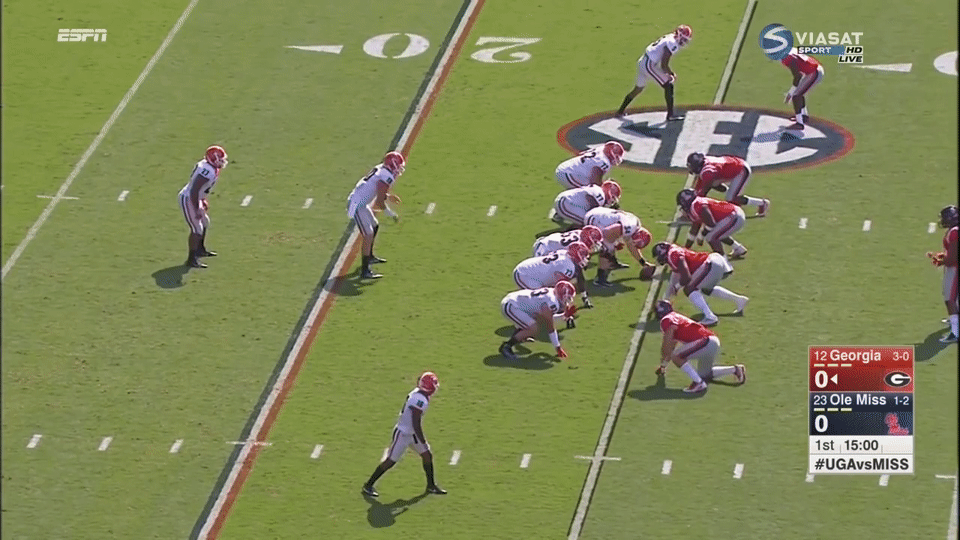
These are cherry-picked examples, and they don’t cover the full breadth of Georgia’s problems. (Short-yardage, for example, has been dicey: The Bulldogs are just 7-of-13 on third-down runs with three yards or less to go.) And more traditional, I-formation running hasn’t necessarily yielded better results than the spread stuff. But the common thread is clear enough: Too many opposing jerseys in the backfield, preventing the backs — and Chubb especially — from getting where they want to go and hitting the gas.
TO SATURDAY AND BEYOND
The most pressing question against Tennessee is whether the headliner will be able to play at all: Chubb sat out the second half against Ole Miss with a sprained ankle and didn’t practice Wednesday; his status is “day to day,” according to coach Kirby Smart, and as of mid-week not looking very encouraging.
Meanwhile, Michel said last week he’s “back to normal” after breaking his arm in July in an ATV accident and could be in line to pick up more of the slack if Chubb can’t go. (Michel has just 23 carries for the season after sitting out the opener against UNC and easing back into the lineup the last few weeks.) But the inability to get them on the field together, at full speed, remains an ongoing frustration — out of 30 games since Chubb and Michel arrived on campus in 2014, one or the other has been held out with injury in 14 of them.
Even if Chubb wakes up Saturday morning feeling 100 percent, though, it won’t mean anything against a nasty Volunteers front without a better push up front than he and the other backs have seen the past three weeks.
One way to do that with a largely immobile quarterback might be to emphasize what worked against UNC — old-school, downhill running behind a fullback or H-back — which also happens to be how Chubb came by most (though certainly not all) of his yardage in 2014 and ’15.
Running out of shotgun and spread sets often means more slowly developing runs and fewer opportunities for a powerful, one-cut runner like Chubb to build momentum and accelerate through a crease, especially when the defense is basically free to ignore the possibility that Eason might tuck and run with it himself.
But to a very large extent improvement is simply a matter of execution: No play will work if the blocking doesn’t come off.
We do know that if the line can spring them to the second level cleanly, Chubb, Michel, and Herrien have all shown the wiggle, the wheels, and (in Chubb’s case, anyway) the power to turn an ordinary run into a big one.
And even if he’s not much of a runner himself, no one will benefit more from a steady ground game than Eason, who has lived up to the hype at times but doesn’t look ready to carry the offense to the extent he has in his first two SEC games for a team with designs on winning the East. That goal is still real, as is the potential to meet it. But only if the Bulldogs find a way to get back to doing what they should do best.
Matt Hinton, author of 'Monday Down South' and our resident QB guru, has previously written for Dr. Saturday, CBS and Grantland.







